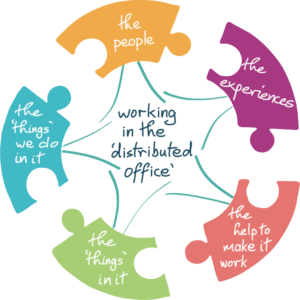The Distributed Office – the journey so far…
By Michael Sinnott, UCD Agile
Like all good ideas, at the heart of the ‘Distributed Office’ concept is a story… the story of a journey… the people that shape it… a story we all have yet to finish writing.
On March 13th we started working from home. While a lockdown had begun to seem likely, it was still a shock when it came, leaving most of us to suddenly switch to being able to work from home, whilst also coping with all the other complexity and associated stress and uncertainty.
Dust settled, immediate needs began to be met, more persistent needs started to become clearer as we moved into April and beyond. We have the privilege of working with many colleagues from across the University and gradually a pattern of needs began emerging from the various channels close to Agile:
- the work of the USM Rollout team;
- the USM-supported Remote Working Group;
- the Distributed Office Survey;
- Agile’s engagement / workshops with teams across UCD; and
- the WST Summer School 2020.
It is an obvious point, of course, but everyone was trying to continue to do their own work, and the work of their office whist scattered around Dublin, the surrounding counties, the four corners of Ireland and beyond. This involved re-inventing ‘the office’ – what we do in it, the things we need (material, space, equipment, systems), the people we work with, the experiences shaped and created, and the ability to access and use the help we need in doing all of this.
On Wednesday 11th March, it was “I (pretty much) have all the things I need to do my job” and on Friday 13th it was “I don’t know if I have everything I need, and I’m not sure how to fill the gaps I spot”.
The main theme that emerged was about helping folks work in their ‘distributed office’ – it was still ‘the office’ – but no longer in the same room or down the corridor from colleagues – we are all now ‘distributed’ around city / county / country. (And ‘distributed’ sounds a bit better than ‘remote’, especially as some folks are on campus and never left).
This is where the ‘Distributed office’ concept came from.
On 22nd October, we held our annual Work Smarter Together October event. The theme was Getting things done in the Distributed Office.
So the ‘distributed office’ concept has five elements:
- the things in it – computers, systems, templates, paper etc.
- the things we do – delivering the work we are responsible for
- the people – the folks we work with and for, the connections, the belonging
- the experiences – how we work together, the experiences we shape for others
- the help we use – those outside our office we draw on to make its ‘doing’ possible
You could easily imagine meeting with your colleagues and checking how your ‘distributed office’ is doing against each of these. And when you have checked the health, and spotted some challenges / opportunities, where do you turn?
DO Training
The DO ‘brand’ we in Agile are developing, is aimed at helping folks work in their ‘distributed office’ (hence the ‘DO’). Driven by the insights of the Distributed Office Survey mentioned above, we are starting with four DO Training sessions – remote workshopping, ad hoc query management, streamlining meetings and the “Where are we now?” you need at the start of a change journey of some kind.
A sub-theme in what we have seen is the key question: Copy or create? How do we spend less time building the ‘distributed office’ around us and spend more on doing the doing? How can we benefit from the experience and hard work of others, and share the benefits of the good stuff we have come up with?
Another theme is the innovation we see everywhere (“necessity is the mother of…”) People find great value in coming together to find solutions to common needs, picking up on the good ideas of others. Innovation is thriving. Experiences were shared in our WST October event ‘Tales from the Distributed Office’ of how solutions are being found by people and teams around UCD.
This story of our working in the ‘distributed office’ continues to unfold… and we in UCD Agile will continue to expand our DO Training offerings and resources. Check into Work Smarter Together Website for updates – that’s the home of the ‘distributed office’ (metaphorically speaking).
